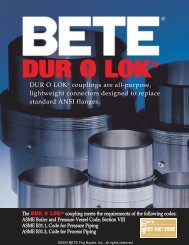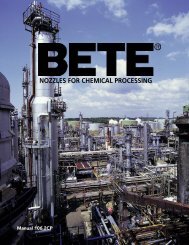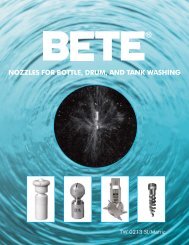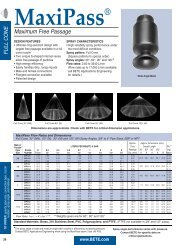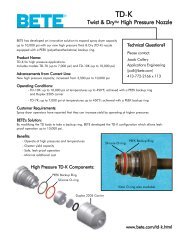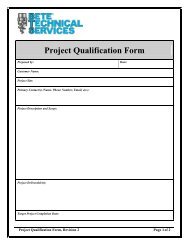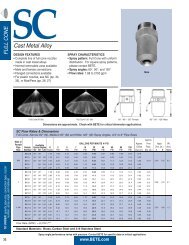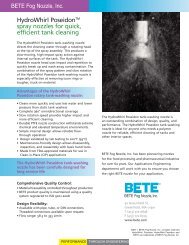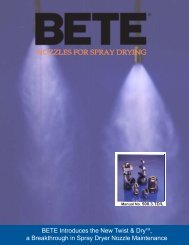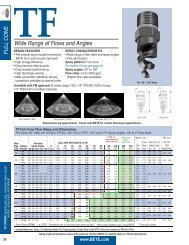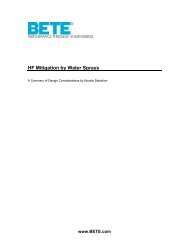Spray Gas Quench Design Considerations - BETE Fog Nozzle, Inc.
Spray Gas Quench Design Considerations - BETE Fog Nozzle, Inc.
Spray Gas Quench Design Considerations - BETE Fog Nozzle, Inc.
- No tags were found...
You also want an ePaper? Increase the reach of your titles
YUMPU automatically turns print PDFs into web optimized ePapers that Google loves.
Acid <strong>Gas</strong> <strong>Quench</strong>A customer’s acid gas recovery fromenergy efficient thermal treatmentsystems required the cooling ofHydrogen Chloride acid gas betweena heat recovery boiler exit from 250° Cto 50° C at the entrance of an absorptiontower. The quench liquid for this wet-walldesign was the strong acid from theabsorber tower. As with many wet-walldesigns, the amount of evaporation of thequench liquid is approximately 10%.Entrainment of small droplets into thepacked tower reduces the countercurrentabsorption efficiency. Therefore, a largerdrop size with sufficient surface area forheat transfer was needed. A cost effectivesolution was required that was compatiblewith the corrosive hot aqueous HCl.The nozzle selected by <strong>BETE</strong> ApplicationsEngineering <strong>BETE</strong> TF 16 FC made fromglass filled PTFE. This material choiceallows operations with HCl at approximately30 psi to achieve the drop size of350 micron required for the heat transfer.These nozzles were mounted in anejector venturi inducing gas flowthrough the system.<strong>Gas</strong> Cooling ExampleA confidential process being developedby a customer required the cooling gasstream to be instantaneous and uniform.The drop size needed to achieve the50-millisecond evaporation time andquench liquid flow rate restricted thenozzle type to the two-fluid nozzle. Steamwas chosen as the atomizing gas mediumbecause any non-condensable gas wouldadd to the overall process complexity.The <strong>BETE</strong> XASR external-mix nozzlewas selected to allow the most efficientuse of steam. An internal mix nozzlewould have required additional steamto preheat the liquid to saturation.The process performance met allexpectations for the entire range ofoperating conditions and rates.SummaryAn optimized spray quench designrequires engineering analysis of theoperating environment, spray nozzleperformance and process reliability.<strong>BETE</strong> Applications Engineers willpartner with you to develop andoptimize the quench system for yourapplication. Our analysis tools andexperience with hundreds of applicationsprovide a rapid and robust engineeringdesign of your spray quench system.The result is a quench system thatoperates efficiently and reliably foryour process.<strong>BETE</strong> <strong>Fog</strong> <strong>Nozzle</strong>,<strong>Inc</strong>.50 Greenfield St.Greenfield, MA 01301 USAT (413) 772-0846F (413) 772-6729www.bete.com9PERFORMANCE THROUGH ENGINEERING



